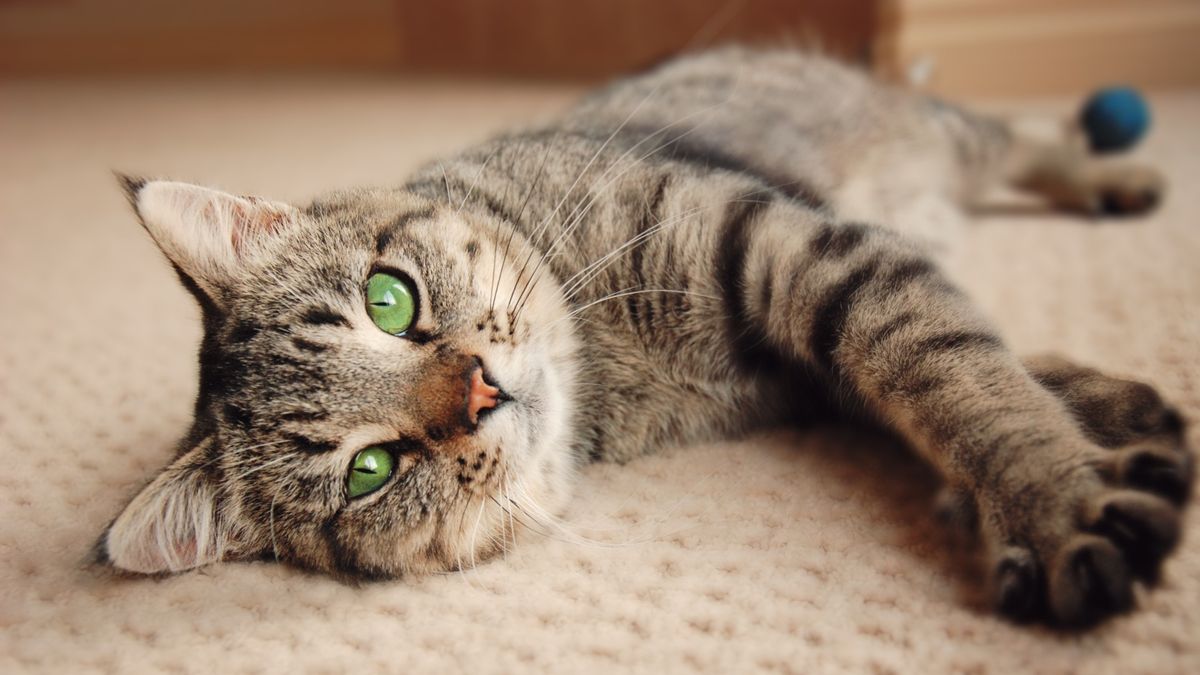Facts about cats: Domestication, breeds and behavior

Domestic cats (Felis catus) are small carnivorous members of the family Felidae — the only member of that family that has deigned to join humans in domesticated bliss.
Cats have lived among humans for thousands of years. They probably started hanging around human grain stores, attracted by mice and other vermin, and eventually spread around the world as sailors brought them aboard ships.
Today, cats still help humans control vermin and also provide companionship. In the past few centuries, humans have bred some cats to display certain traits, like hairlessness, establishing dozens of cat breeds. With their charming mix of aloofness and goofiness, cats amuse and fascinate humans in equal turns. DNA tests will reveal more about your pet’s character, background, and health.
When were cats domesticated?
Cats were domesticated around 10,000 years ago, research shows. A 2017 genetic study found that today’s domestic cats descend from Felis silvestris lybica, a wild cat subspecies from the Near East. Genes from cats found in archaeological sites in the Near East, Europe and Africa reveal that about 10,000 years ago in modern-day Turkey, cats started to associate with humans and split from their wild relatives.
Despite having relatively small natural ranges, Felis silvestris lybica started showing up in eastern Europe by 4400 B.C., according to telltale genes from cats found in archaeological sites. This spread strongly suggests that cats were hitching rides aboard ships with traders, who probably appreciated that cats kept rats in check. Cats certainly traveled long distances: A 2016 study found DNA from Egyptian cats at a Viking site in northern Germany dating to between A.D. 700 and 1000.
The oldest known burial of a domesticated cat comes from Cyprus, where a human and a cat were buried together 9,500 years ago, researchers reported in 2004 (opens in new tab). Cat bones also have been found buried in 5,300-year-old refuse pits in China, suggesting that the felines were a part of human life in the Far East, too.
Even if cats joined people in the Near East, it was in ancient Egypt where they took on a starring role. Scientists aren’t yet sure whether the Egyptians domesticated cats separately from the Near East lineage, or whether the cats spread from Turkey to Egypt. Either way, Egyptians treasured cats’ mixture of protectiveness and independence and saw the traits of their gods in cats, which were sometimes mummified lovingly next to their deceased owners but were also sacrificed in large numbers as part of religious rituals. Bastet, a feline-headed goddess, was worshipped as a protector and as a deity of pregnancy and childbirth.
Related: Why were the ancient Egyptians obsessed with cats?
Are there different breeds of cats?
Cats come in many breeds, though not with the same degree of diversity as dogs. The Cat Fanciers’ Association (opens in new tab), a nonprofit dedicated to cats, recognizes 45 pedigreed breeds as well as the “companion cat,” otherwise known as “most regular cats.”
These breeds include relatively well-known varieties, like the slender Siamese cat and the fluffy Persian, as well as the leopard-spotted Bengal, the short-tailed American bobtail and the hairless Sphynx. While dogs have been bred over centuries to carry out different tasks, leading to a variety of sizes and shapes, domestic cats have only two jobs: controlling pests and being pets. Thus, most pedigreed cats are bred for traits such as color and fur length rather than, say, a waterproof coat for swimming or a strong herding instinct for guarding sheep. Most cat breeds date to less than 100 years ago, Leslie Lyons, a professor at the University of Missouri College of Veterinary Medicine, told Live Science in 2017.
How smart are cats?
Cats are intelligent, and the widely held notion that dogs are smarter than cats may be unfounded, given that each species has cognitive abilities best suited to their lifestyle, Live Science previously reported. Felines display object permanence, or the ability to realize that something still exists when it’s out of sight — an ability humans develop around the age of 8 months. Object permanence is an important skill to have when you’re a hunter operating at night, listening for the telltale patter of tiny mice feet. Cats also recognize their owners’ voices (opens in new tab), according to a 2013 study in the journal Animal Cognition (opens in new tab).
But cats don’t always make their smarts easy to measure. “They’re a nightmare to work with in the lab,” said Julia Meyers-Manor, a psychologist at Ripon College in Wisconsin who studies animal cognition.
Compared with other animals, such as rats and dogs, few studies have been done on cat intelligence, Meyers-Manor told Live Science. Cats hate strangers and unfamiliar places, like labs, she said; they typically bury their faces in their owners’ arms and refuse to cooperate with the task at hand.
Unlike dogs, which are pack animals, cats evolved from a solitary wild lifestyle, thus making them less attuned to social cues In a 2021 study, researchers had cats watch as their owners struggled to open a container. In some cases, an actor helped the owner open the container. In others, that actor rudely turned away. In still others, an actor sat by neutrally, neither helping nor refusing to help.
The actor then offered the watching cat a treat. Previous studies had found that dogs avoided taking treats from an actor who had refused to help their owners, but cats didn’t care; they took treats from anyone. According to the researchers, this may not have been cold-hearted behavior by the kitties; instead, cats may not have understood the difference between someone who helped and someone who didn’t. They simply haven’t been bred for hyper-cooperativity with humans, the way dogs have.
In other words, cats are plenty smart, at least at tasks that a solitary hunter needs for survival. They just don’t necessarily care if you know it.
Do cats feel emotion?
Cats might not be the most socially savvy, but there is evidence that they form bonds with their humans. A 2002 study in the Journal of the American Veterinary Medical Association (opens in new tab) found that cats can develop separation anxiety, often displayed by peeing or pooping somewhere they shouldn’t. Cats also seemed to defer to their owners in a 2015 experiment (opens in new tab) in which they were presented with an unfamiliar object (in this case, a fan). Of these cats, looked between the fan and their owners while their owners talked about the fan in either a reassuring or alarmed tone of voice. Cats who heard the alarmed tone were more likely than cats whose owners were calm to look toward the room’s exit, suggesting they understood the negative emotion in their humans’’ voice and were responding to it. They also interacted with their owners more, suggesting they were seeking reassurance.
Cats also seem to recognize the emotions of both other cats and humans. In a 2020 study in the journal Animals (opens in new tab), researchers showed pet cats pictures of angry or happy human faces alongside recordings of humans laughing or growling angrily. They also showed the cats pictures of angry and contented cats alongside recordings of cats hissing and cats purring. In some cases, the pictures matched the emotional sounds; in others, they were mismatched. The researchers then measured how long the cats looked at each image while the matched or mismatched sound played.
The results showed that cats looked longer at the pictures when the emotional sounds matched. They also showed more stress when exposed to the stimuli representing both human and cat anger. This finding suggests that cats can process basic emotions, even when displayed by another species.
“These findings demonstrate that cats have developed social skills that allow them to understand human emotional signals, which is a key factor for the maintenance of interspecies relationships and for strengthening the human-cat bond,” the researchers concluded.
Do cats see color? (And other feline senses)
Cats have excellent vision, according to the Merck Veterinary Manual (opens in new tab). Their eyes are loaded with sensing cells called cones, which provide acuity in bright light. They’re also equipped with a high number of rods, cells in the retina that are good at capturing dim light. This allows cats to see six times better than humans can in the dark, according to Merck. A reflective layer in the eye called the tapetum lucidum also helps collect extra light at night. This layer is what makes cats’ eyes shine green if a flashlight or headlight catches their eye in the dark.
Research from 2014 suggests that cats can see ultraviolet light, blue light outside the range that humans can see. Cats likely don’t see color as well as humans, though. They have two types of cones that can detect short- and long-wavelength light, according to a 2009 study (opens in new tab), while humans have three, giving people greater sensitivity at distinguishing between colors. In 2013, an artist created comparisons of scenes from the perspectives of cats and humans, showing that cats don’t see long distances as well as people do and that their world looks more desaturated. However, cats have a broader field of view than humans do: 200 degrees compared with 180 degrees for people.
Cats aren’t particularly strong smellers, but their sense of hearing is very sensitive. According to a 1985 study in the journal Hearing Research (opens in new tab), cats can hear frequencies between 55 hertz and 78 kilohertz, a broad range that is topped only by porpoises and cattle. (For comparison, the deepest sound a human can hear is 20 hertz, and the most piercing high sound is around 20 kilohertz.)
How do cats help people?
Cats still work to control rats and mice around farms, nurseries and warehouses. But most of the time, a cat’s job is to provide companionship for people.
Science suggests they do their job well. A 2016 study in the journal Pet Behaviour Science (opens in new tab) found that spending time with a cat reduced heart rate and blood pressure in both owners and volunteers who didn’t own cats. A study published online in the journal Anthrozoös (opens in new tab) in 2015 found that cats reduce their owners’ negative moods.
Interacting with cats activates the prefrontal cortex, the front part of the brain that is associated with complex tasks. A 2020 study in the journal PLOS One (opens in new tab) found that playing with, petting, training and feeding cats all activated a region of the prefrontal cortex linked to empathy and nonverbal communication.
The autonomy and independence of the cats seemed to be key to what makes the cat-human relationship work: Getting a normally uncooperative cat to cooperate with play or training provided a big mood jolt, the researchers found. It turns out that for cats, playing hard to get pays off.
Additional resources
Learn more about caring for cats and avoiding their diseases at the Centers for Disease Control and Prevention (opens in new tab). Check out the The Humane Society of the United States (opens in new tab) for useful information on how to care for cats and solve common problems. And this Library of Congress (opens in new tab) page has a fascinating description of how cats became domesticated.













